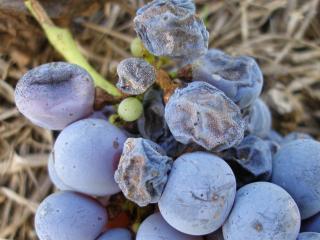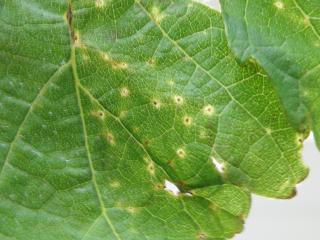Bunch rots can be caused by several different fungi, many of which produce similar symptoms on the berries. Confusion over the cause of the bunch rot can lead to poor management decisions and crop failures.
Accurately identifying the cause of a bunch rot on your vines is critical so the correct control strategy can be implemented.
Bunch rots can affect both wine and table grapes and control options differ depending on location, variety and trellising. If you suspect a non-botrytis bunch rot is the problem in your vines, samples can be sent to DDLS Seed Testing and Certification for diagnosis.
Botrytis bunch rot
Botrytis is the most common bunch rot found in WA and the most damaging. It is caused by the fungus Botrytis cinerea. Bunch rots caused by other fungi are often attributed to botrytis due to its prevalence.
Botrytis infection can occur at flowering although symptoms may not be obvious until close to harvest. Berry symptoms initially appear as water-soaked spots where the skin easily slips off the berry — known as slip skin. After infection, the berry changes colour and grey fungal growth appears. Botrytis spreads easily to other berries as the fungus sporulates. Berries may shrivel and become mummified if hot conditions occur after infection. Numerous chemicals are registered for its control and cultural techniques minimise loss. For more information refer to Botrytis in wine grapes in Western Australia.
Aspergillus
Aspergillus rot is common on mature berries and is generally considered a secondary invader. However, it is known to infect intact berries directly through their skins during warm temperatures (20–30°C) when water is present. Infected berries are initially tan to brown, but are soon covered with masses of brown or black spores.
Bitter rot
Bitter rot is caused by the fungus Greeneria uvicola and is usually only associated with ripe fruit. Infection occurs at flowering but remains latent until berry maturity. White berries turn brown and concentric rings of spore bodies eventually cover the entire affected berry. Berries soften and detach easily from the bunch. Optimum infection occurs at 28–30°C.
Bitter rot is not known to occur in WA and suspected infections should be reported to the Pest and Disease Information Service (PADIS) on 1800 084 881.
Black spot
Commonly referred to as anthracnose, this is a wet weather disease that occurs sporadically in WA. It is generally more visible as a foliar infection but on berries it produces circular lesions that have black margins which turn white with age.
Botryosphaeria bunch rot
Commonly associated with trunk disease symptoms, Botryosphaeria species are known to cause bunch rot and have been found in all growing regions of WA. They are generally only seen close to harvest and disease progression is rapid. Initial symptoms look similar to botrytis bunch rot, with water-soaked berries that change colour. As the infection progresses, small black pimples appear on the berry surface before the berry shrivels, possibly falling from the stalk.
Cladosporium rot
Infected berries develop black, soft circular lesions which can cover almost the entire berry and produce olive velvet patches. Infection is favoured by delayed harvest or berries with high phenolic maturity. Berry damage is required for infection.
Downy mildew
Berries are susceptible to downy mildew infection until they are about pea size but the bunch stem and berry stem remain susceptible. White down can be seen on recently infected tissue. After infection, the tissue stops growing, turns brown, shrivels and dies.
Penicillium
This secondary disease is characterised by berries covered in a mass of coloured spores, usually blue or green. Infection is more obvious on mature berries and can be associated with a musty or mouldy odour.
Phomopsis bunch rot
This rot is associated with distinctive small black leaf spots with yellow halos and black lesions on the lower sections of canes. Phomopsis viticola berry infection is rarely seen in eastern Australia but is favoured by prolonged spring rainfall. It can be confused with Botryosphaeria rot.
Phomopsis viticola is not known to occur in WA and suspected infections should be reported to the Pest and Disease Information Service (PADIS) on 1800 084 881.
Powdery mildew
Although not recognised as a bunch rot, powdery mildew can infect immature berries between flowering and up to four weeks later. Severe infection can scar the berry surface. As the berry ripens, the scar cracks and splits, leading to infection from other bunch rots such as Botrytis.
Rhizopus species
Numerous white fungal stalks with small circular spore heads develop from berries infected with Rhizopus species. Infected berries become soft, brown and ooze juice to adjacent berries, spreading the infection.
Ripe rot
Caused by different species of Colletotrichum, this bunch rot is usually associated with warm weather (above 25°C). Infected berries develop a reddish brown circular spot at the infection site that eventually covers the whole berry. Characteristic salmon or orange-coloured spore masses are produced on the rotting berry. This is rarely seen in WA, despite the causal fungi being recorded here.

Sour rot
Sour rot is caused by a mixture of fungi, yeast and bacteria. It is characterised by a vinegar smell and the presence of vinegar flies, the larvae of which help spread the rot throughout the bunch.
Sour rot begins as a secondary invader but juice from affected berries can drip onto nearby berries, causing cracks in the skin and infecting others.

